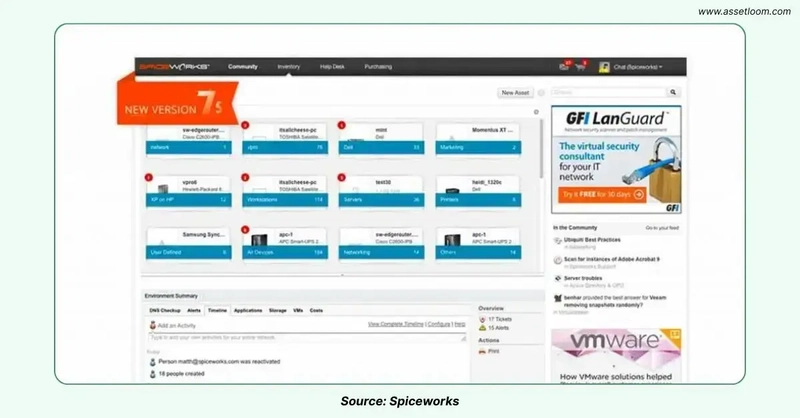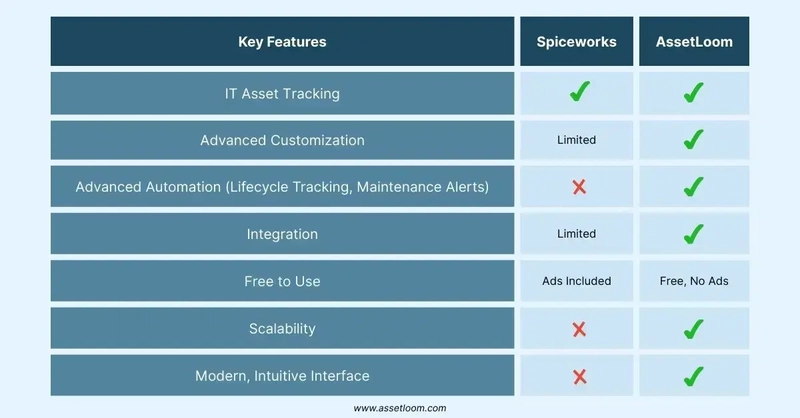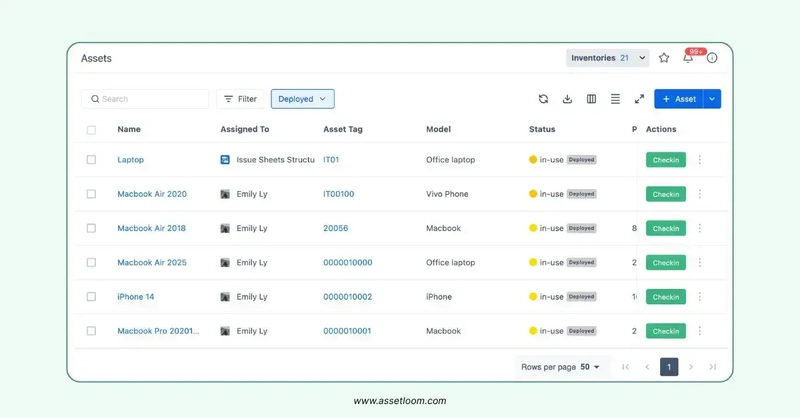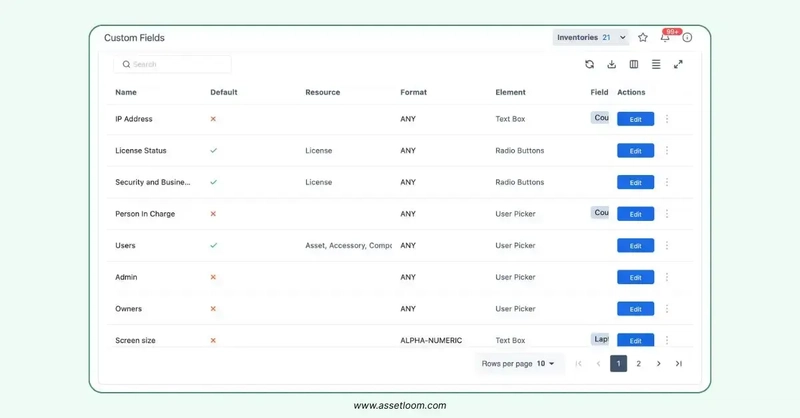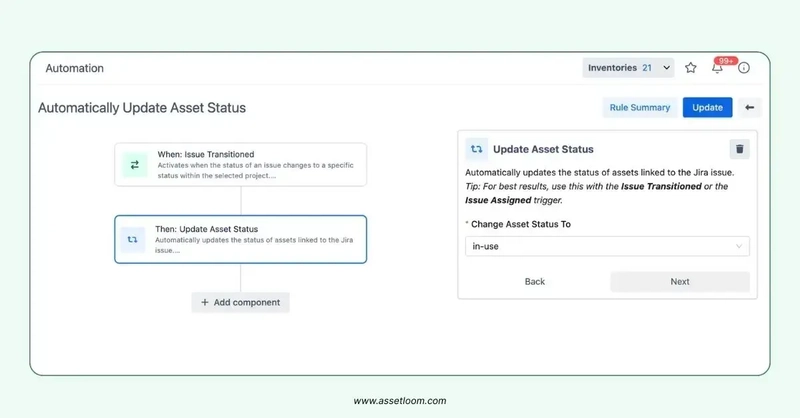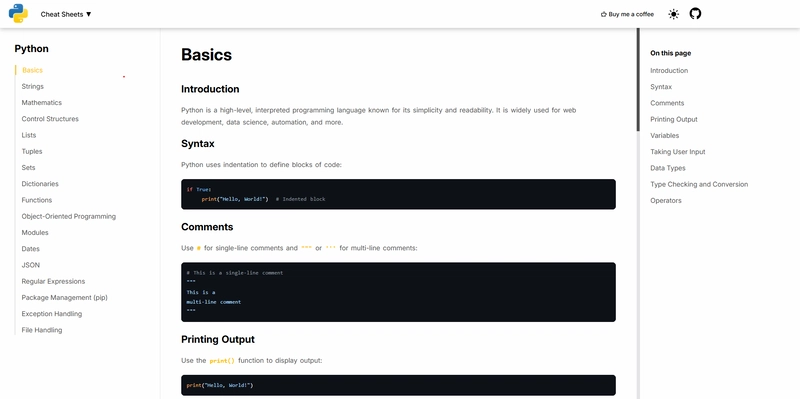Spiceworks IT Asset Management: Features and Limitations for IT Teams
Spiceworks IT asset management has been well recognized for its capabilities in terms of managing hardware and software assets. This tool provides a cloud-based ITAM platform to help organizations track, monitor, and support their IT ecosystem. Let’s explore Spicewoeks in terms of its functions and limitations in this article. Eventually, you can decide if the tool is a perfect fit for your team. Learn More. Features of Spiceworks IT Asset Management Spiceworks IT asset management delivers a robust set of tools to streamline IT asset management, combining asset tracking, network monitoring, and help desk integration into a single cloud-based platform. Below, we dive into the core features that make Spiceworks a compelling choice. 1. Device Discovery and Tracking Spiceworks IT asset management excels at automating the discovery of networked devices, from laptops and servers to printers and IoT gadgets. Using an IP scanner, it identifies devices and captures detailed data like serial numbers, IP addresses, hardware specifications (CPU, RAM, storage), and installed software. The scanner can run on-demand or on a schedule, with optional agents for deeper insights into user activity or real-time status updates. This feature saves IT teams hours of manual inventory work, ensuring an accurate, up-to-date view of the network. For example, a small business with 50 employees can quickly map all office devices to prepare for audits, while IT admins can spot unauthorized devices or failing hardware (e.g., low disk space) in near real-time. Its support for Windows, macOS, and Linux makes it versatile for diverse environments. 2. Asset Inventory Management Spiceworks’s inventory management tool function allows unlimited tracking of hardware and software assets, a standout for a free solution. IT managers can assign devices to users, log purchase details (cost, vendor, warranty), and categorize assets by department or location. Software inventory tracks applications, versions, and license counts, helping avoid compliance issues. This centralized database simplifies asset lifecycle management, from procurement to retirement. In daily work, businesses can assign laptops to remote workers and track warranty expirations to plan upgrades, while license tracking ensures software aligns with agreements during audits. The lack of device or user limits makes it scalable for growing organizations. 3. Reporting Spiceworks IT asset management offers flexible reporting to analyze assets, software usage, or network performance. Users can filter data, such as devices by operating system or assets by purchase date, and export reports as CSV files for external use. Reports can be scheduled for recurring audits, supporting tasks like budgeting or compliance checks. These tools empower IT teams to make data-driven decisions. With Spiceworks, IT managers could generate a report on, for example, all Windows 10 devices to plan migrations, or a finance team could use purchase data to forecast spending. While not as visually advanced as some competitors, the reporting is accessible and practical for small teams. 4. Integration with Help Desk A unique strength of Spiceworks is its seamless integration with its native Cloud Help Desk. Asset data links directly to support tickets, so when an employee reports a laptop issue, the ticket auto-populates with the device’s specs and history. The help desk supports rule-based automation, like assigning tickets to specific technicians, and includes a user portal for submitting requests. This integration bridges asset management and IT support, speeding up issue resolution. IT teams could track recurring PC problems and tie them to warranty claims, all within one platform. The fact that this comes at no cost is a significant advantage for resource-strapped organizations. 5. Free to Use Spiceworks’ free model is its biggest draw, offering unlimited access to core features with no trials or paywalls. However, the free version comes with ads and may disturb the experience. Nevertheless, its free plan’s lack of restrictions ensures organizations can scale without unexpected costs. There is also an active community called “Spiceworks Community” that provides peer-driven solutions for common issues. Limitations of Spiceworks ITAM While Spiceworks offers impressive functionality for a free platform, it’s not without drawbacks. Below are the key limitations to consider when evaluating it as an ITAM solution. 1. Clunky User Interface and Performance Issues The platform’s interface feels dated and can be challenging to navigate, especially for new users. Dashboards and menus lack the polish of modern tools, slowing down workflows. The mobile apps, while functional, are less intuitive, limiting their effectiveness for on-the-go management. For small teams with simple needs, this may be a minor inconvenience, but
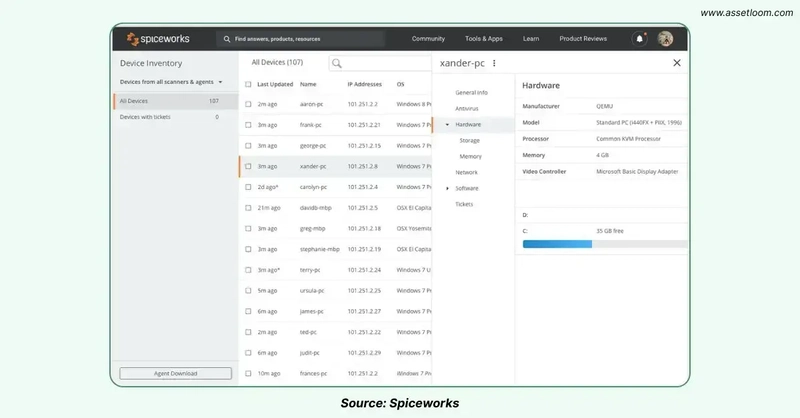
Spiceworks IT asset management has been well recognized for its capabilities in terms of managing hardware and software assets. This tool provides a cloud-based ITAM platform to help organizations track, monitor, and support their IT ecosystem. Let’s explore Spicewoeks in terms of its functions and limitations in this article. Eventually, you can decide if the tool is a perfect fit for your team.
Features of Spiceworks IT Asset Management
Spiceworks IT asset management delivers a robust set of tools to streamline IT asset management, combining asset tracking, network monitoring, and help desk integration into a single cloud-based platform. Below, we dive into the core features that make Spiceworks a compelling choice.
1. Device Discovery and Tracking
Spiceworks IT asset management excels at automating the discovery of networked devices, from laptops and servers to printers and IoT gadgets. Using an IP scanner, it identifies devices and captures detailed data like serial numbers, IP addresses, hardware specifications (CPU, RAM, storage), and installed software. The scanner can run on-demand or on a schedule, with optional agents for deeper insights into user activity or real-time status updates.
This feature saves IT teams hours of manual inventory work, ensuring an accurate, up-to-date view of the network. For example, a small business with 50 employees can quickly map all office devices to prepare for audits, while IT admins can spot unauthorized devices or failing hardware (e.g., low disk space) in near real-time. Its support for Windows, macOS, and Linux makes it versatile for diverse environments.
2. Asset Inventory Management
Spiceworks’s inventory management tool function allows unlimited tracking of hardware and software assets, a standout for a free solution. IT managers can assign devices to users, log purchase details (cost, vendor, warranty), and categorize assets by department or location. Software inventory tracks applications, versions, and license counts, helping avoid compliance issues.
This centralized database simplifies asset lifecycle management, from procurement to retirement. In daily work, businesses can assign laptops to remote workers and track warranty expirations to plan upgrades, while license tracking ensures software aligns with agreements during audits. The lack of device or user limits makes it scalable for growing organizations.
3. Reporting
Spiceworks IT asset management offers flexible reporting to analyze assets, software usage, or network performance. Users can filter data, such as devices by operating system or assets by purchase date, and export reports as CSV files for external use. Reports can be scheduled for recurring audits, supporting tasks like budgeting or compliance checks.
These tools empower IT teams to make data-driven decisions. With Spiceworks, IT managers could generate a report on, for example, all Windows 10 devices to plan migrations, or a finance team could use purchase data to forecast spending. While not as visually advanced as some competitors, the reporting is accessible and practical for small teams.
4. Integration with Help Desk
A unique strength of Spiceworks is its seamless integration with its native Cloud Help Desk. Asset data links directly to support tickets, so when an employee reports a laptop issue, the ticket auto-populates with the device’s specs and history. The help desk supports rule-based automation, like assigning tickets to specific technicians, and includes a user portal for submitting requests.
This integration bridges asset management and IT support, speeding up issue resolution. IT teams could track recurring PC problems and tie them to warranty claims, all within one platform. The fact that this comes at no cost is a significant advantage for resource-strapped organizations.
5. Free to Use
Spiceworks’ free model is its biggest draw, offering unlimited access to core features with no trials or paywalls. However, the free version comes with ads and may disturb the experience. Nevertheless, its free plan’s lack of restrictions ensures organizations can scale without unexpected costs. There is also an active community called “Spiceworks Community” that provides peer-driven solutions for common issues.
Limitations of Spiceworks ITAM
While Spiceworks offers impressive functionality for a free platform, it’s not without drawbacks. Below are the key limitations to consider when evaluating it as an ITAM solution.
1. Clunky User Interface and Performance Issues
The platform’s interface feels dated and can be challenging to navigate, especially for new users. Dashboards and menus lack the polish of modern tools, slowing down workflows. The mobile apps, while functional, are less intuitive, limiting their effectiveness for on-the-go management. For small teams with simple needs, this may be a minor inconvenience, but larger organizations or those prioritizing user experience may find it frustrating.
Furthermore, users frequently report slowdowns, particularly in larger networks or during peak usage. This may stem from cloud infrastructure or agent-based scanning, which requires software installation on devices for full functionality. In distributed or non-Windows environments, setup can be cumbersome. For small networks (e.g., < 100 devices), performance is generally adequate, but scalability falters for complex setups, potentially requiring workarounds.
2. Limited Advanced Features
Spiceworks covers the basics well but lacks sophisticated features like automation, usage alerts, or multi-stage approval workflows. Reporting, while customizable, doesn’t support complex analytics or interactive visualizations, making it less suited for in-depth audits or high-value asset tracking. Organizations with advanced needs, such as automated lease notifications or predictive maintenance, may need to supplement Spiceworks with other tools or look elsewhere.
3. Ad-Supported Model
The free plan includes ads targeted at IT professionals, which some users find intrusive. These can disrupt workflows, especially during intensive tasks. An ad-free “My Way” plan costs $45/month, but this defeats the free appeal for budget-conscious users. This seems to be inconvenient for those seeking a seamless experience, unless they are willing to pay.
4. No On-Premises Option
Since the desktop version reached end-of-life in 2021, Spiceworks is cloud-only. This lacks the control of on-premises solutions, a dealbreaker for organizations with strict data residency or security requirements (e.g., government agencies). There’s no indication of a return to on-premises support, limiting flexibility.
5. Limited Customization and Scalability
While functional, Spiceworks lacks deep customization for ticket forms, dashboards, or workflows. Asset management tools don’t allow granular task separation, which can complicate role-specific access. Compared to ManageEngine or SysAid, it feels rigid for tailored processes. Organizations with unique workflows may need to adapt to Spiceworks’ structure rather than fully customizing it to their needs.
What’s more, Spiceworks IT asset management is optimized for small to medium-sized businesses but struggles with larger fleets (e.g., >200 assets). Database management issues and a lack of advanced automation hinder performance in complex environments. Growing companies may outgrow Spiceworks, requiring a migration to more robust platforms as their needs evolve.
6. Compliance and Integration Gaps
The platform isn’t HIPAA-compliant, ruling it out for healthcare settings. It also has limited integrations with third-party tools, unlike competitors that sync with CRMs or accounting software. This can isolate Spiceworks from broader IT ecosystems, requiring manual data transfers.
Organizations needing compliance certifications or tight integrations may find Spiceworks restrictive.
Who Should Use Spiceworks?
Spiceworks shines for small to medium-sized businesses, schools, or nonprofits seeking a free, all-in-one ITAM solution. Its unlimited asset tracking, help desk integration, and network monitoring make it a practical choice for managing 10-200 devices without breaking the bank. The cloud-based model suits distributed teams, and the community support adds value for those comfortable troubleshooting independently.
However, it’s less ideal for larger organizations, compliance-driven industries, or teams needing advanced customization or on-premises control. The clunky interface, ads, and performance hiccups may frustrate users prioritizing polish or scalability. For these cases, an alternative IT asset management tool might better align with complex needs.
Spiceworks Alternative: How AssetLoom Stands Out
For organizations exploring IT Asset Management (ITAM) solutions, Spiceworks offers a compelling free option, but it’s not the only choice. AssetLoom emerges as a modern alternative, designed to address some of Spiceworks’ limitations while delivering a streamlined, user-friendly experience. Below, we compare the two platforms across key areas to highlight why AssetLoom might be the better fit for businesses seeking enhanced functionality, scalability, and polish.
Modern Interface
With an intuitive asset list and easy-to-access interface, AssetLoom eliminates the pain point of Spiceworks. Even users new to IT systems can quickly locate device details or generate reports, saving time and reducing frustration for teams of all skill levels.
Robust Customization
One of the most outstanding features of AssetLoom lies in its ability to customize literally everything. Need more fields for your asset data? Get the fields created. Want a personalized dashboard? Feel free to choose exactly what attributes you want to see. Even the app permission can also be customized to match your team’s roles and access levels.
Unlimited Scalability
Spiceworks struggles in larger environments (e.g., >200 assets), with performance slowdowns and database management issues limiting its scalability. AssetLoom addresses this with the ability to handle thousands of assets without compromising speed or reliability. Growing companies can trust AssetLoom to keep pace, while ensuring smooth performance.
Advanced Automation
Spiceworks’ basic feature set, like missing tools like geofencing, usage alerts, or multi-stage workflows, limits its ability to handle complex ITAM needs. AssetLoom elevates asset management with advanced capabilities, such as automated lifecycle tracking, predictive maintenance alerts, and detailed analytics. For example, IT teams can set notifications for lease expirations, making sure you are always up-to-date.
Final Thoughts
Spiceworks IT Asset Management delivers a free solution with device discovery, asset tracking capabilities. However, its limitations can frustrate large organizations or those with complex needs. For teams seeking a modern alternative, AssetLoom stands out by directly tackling those pain points, adding to its advanced asset tracking features.
Ultimately, choosing between Spiceworks and AssetLoom depends on your priorities. If cost-free basics are enough, Spiceworks delivers. But if you need flexibility, performance, and a modern vibe to grow with your IT demands, AssetLoom is the smarter pick. Explore both to find the perfect fit for your team’s ITAM journey.




























![[Webinar] AI Is Already Inside Your SaaS Stack — Learn How to Prevent the Next Silent Breach](https://blogger.googleusercontent.com/img/b/R29vZ2xl/AVvXsEiOWn65wd33dg2uO99NrtKbpYLfcepwOLidQDMls0HXKlA91k6HURluRA4WXgJRAZldEe1VReMQZyyYt1PgnoAn5JPpILsWlXIzmrBSs_TBoyPwO7hZrWouBg2-O3mdeoeSGY-l9_bsZB7vbpKjTSvG93zNytjxgTaMPqo9iq9Z5pGa05CJOs9uXpwHFT4/s1600/ai-cyber.jpg?#)











































































































































![[The AI Show Episode 144]: ChatGPT’s New Memory, Shopify CEO’s Leaked “AI First” Memo, Google Cloud Next Releases, o3 and o4-mini Coming Soon & Llama 4’s Rocky Launch](https://www.marketingaiinstitute.com/hubfs/ep%20144%20cover.png)





























































































































![[FREE EBOOKS] Machine Learning Hero, AI-Assisted Programming for Web and Machine Learning & Four More Best Selling Titles](https://www.javacodegeeks.com/wp-content/uploads/2012/12/jcg-logo.jpg)








































































![Rogue Company Elite tier list of best characters [April 2025]](https://media.pocketgamer.com/artwork/na-33136-1657102075/rogue-company-ios-android-tier-cover.jpg?#)








































































_Andreas_Prott_Alamy.jpg?width=1280&auto=webp&quality=80&disable=upscale#)





























































































![What’s new in Android’s April 2025 Google System Updates [U: 4/18]](https://i0.wp.com/9to5google.com/wp-content/uploads/sites/4/2025/01/google-play-services-3.jpg?resize=1200%2C628&quality=82&strip=all&ssl=1)










![Apple Watch Series 10 Back On Sale for $299! [Lowest Price Ever]](https://www.iclarified.com/images/news/96657/96657/96657-640.jpg)
![EU Postpones Apple App Store Fines Amid Tariff Negotiations [Report]](https://www.iclarified.com/images/news/97068/97068/97068-640.jpg)
![Apple Slips to Fifth in China's Smartphone Market with 9% Decline [Report]](https://www.iclarified.com/images/news/97065/97065/97065-640.jpg)
































































































































